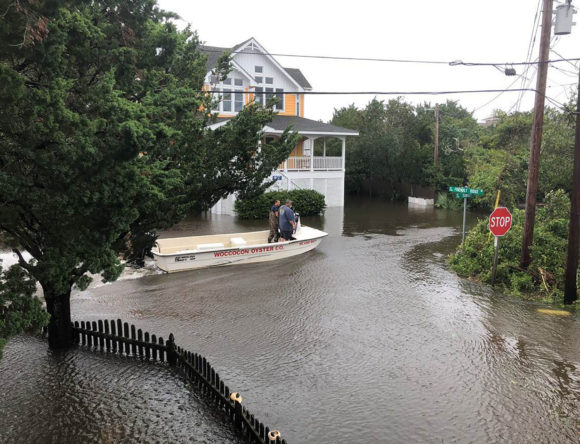Skies cleared and floodwaters receded Saturday from North Carolina’s Outer Banks, leaving behind a muddy trail of destruction wrought by Hurricane Dorian, which turned north and began lashing parts of eastern Canada.
Dorian’s worst damage in the U.S. appeared to be on Ocracoke Island, which even in good weather is accessible only by boat or air and is popular with tourists for its undeveloped beaches. Longtime residents who hunkered down to wait out the storm described strong but manageable winds followed by a wall of water that flooded the first floors of many homes and forced some to await rescue from their attics.
“We’re used to cleaning up dead limbs and trash that’s floating around,” said Ocracoke Island resident and business owner Philip Howard. “But now it’s everything: picnic tables, doors, lumber that’s been floating around.”
Howard said by phone Saturday that flooding at his properties on the North Carolina island is 13 inches (0.3 meters) higher than the levels wrought by a storm in 1944, which he said had long been considered the worst. He raised his home higher than the 1944 flood level and still got water inside.
“It’s overwhelming,” said Howard, who owns the Village Craftsmen, a store that sells handcrafted pottery, glass and kitchen items. He said much of the merchandise on the lower shelves is ruined. Pieces of pottery were floating around inside.
Inside his house, the floorboards were buckling and curling up after being warped by the water, he said.
Gov. Roy Cooper said about 800 people had remained on the island to wait out Dorian. The storm made landfall Friday morning over the Outer Banks as a far weaker storm than the monster that devastated the Bahamas. Yet despite having been downgraded to a Category 1 storm, it still sent seawater surging into homes on Ocracoke, many for the first time in memory.
More than 1,100 Bahamians arrived in Palm Beach, Florida, after being evacuated by cruise ship from their hurricane-battered islands.
The Grand Celebration cruise ship returned to its home port after setting sail Thursday for Freeport, Grand Bahama, to deliver more than 112 tons of supplies and ferry dozens of health workers and emergency crews.
As it approached Canada, Dorian again picked up strength. The National Hurricane Center in Miami said Saturday the maximum sustained winds had increased to 100 mph (155 kph) from 85 mph (140 kph), raising it to a Category 2 storm.
In North Carolina, the governor said officials were aware of no serious injuries on the Outer Banks from the storm. About 200 people were in shelters and 57,000 without power as of mid-day Saturday, according to the governor’s office. Emergency officials transported fuel trucks, generators, food and water to Okracoke.

“We just thought it was gonna be a normal blow,” Steve Harris, a semi-retired contractor, said Friday. “But the damage is going to be severe this time. This is flooding of biblical proportions.”
Harris lost his car to the storm and his air conditioner is damaged, but he said he’s blessed that his condominium is on the third floor and he is insured.
The U.S. Coast Guard began landing local law enforcement officers on the island Friday by helicopter and airlifting out the sick, elderly and others in distress, Hyde County authorities said. Officers were doing door-to-door checks and offering water and food to residents, according to the sheriff’s office.
At least four deaths in the Southeast were blamed on Dorian. All were men in Florida or North Carolina who died in falls or by electrocution while trimming trees, putting up storm shutters or otherwise getting ready for the hurricane. North Carolina’s governor on Saturday urged returning residents to be vigilant, as many of the injuries and deaths from previous storms happened during the cleanup process.
Dorian slammed the Bahamas at the start of the week with 185 mph (295 kph) winds, killing at least 43 people and obliterating countless homes. From there, it swept past Florida and Georgia, then sideswiped the Carolinas on Thursday, spinning off tornadoes that peeled away roofs and flipped recreational vehicles.
Still, the damage was far less than feared in many parts of the Carolinas, including historic Charleston, South Carolina, which is prone to flooding even from ordinary storms, and Wilmington, North Carolina, the state’s biggest coastal city.
Ocracoke resident and restaurant owner Jason Wells said he lost three vehicles and a golf cart to floodwaters, and he has $5,000 worth of food in a freezer on an island that still lacks power. He said by text message Saturday that he and family members were already bleaching and disinfecting their houses, but he feared weeks could pass before electricity returned to most houses because of wiring problems caused by floodwaters.
“We are a close knit community. We will power on,” Wells wrote. “We will persevere. We are family. Time to get to work.”
___
Contributing to this report were Associated Press writers Gary D. Robertson, Martha Waggoner and Jonathan Drew in Raleigh, North Carolina; Tom Foreman Jr. in Winston-Salem, North Carolina; Rob Gillies in Toronto; and Seth Borenstein in Washington.
Topics Florida Flood Hurricane North Carolina
Was this article valuable?
Here are more articles you may enjoy.


 OpenAI, Altman Sued Over ChatGPT’s Role in Teen’s Suicide
OpenAI, Altman Sued Over ChatGPT’s Role in Teen’s Suicide  Peloton Must Face Shareholder Lawsuit Over Post-Pandemic Outlook
Peloton Must Face Shareholder Lawsuit Over Post-Pandemic Outlook  Kraft, Other Companies Beat Test Lawsuit Over Ultra-Processed Foods
Kraft, Other Companies Beat Test Lawsuit Over Ultra-Processed Foods  TransUnion Says 4.4 Million Consumers’ Data Compromised in Hack
TransUnion Says 4.4 Million Consumers’ Data Compromised in Hack 

